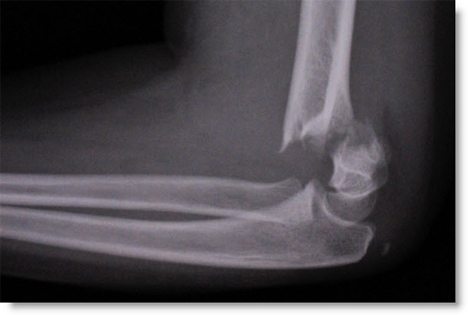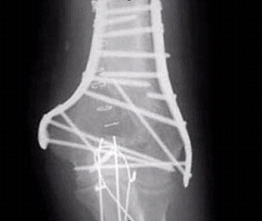Elbow Fractures
What is an Elbow Fracture?
The bones of the elbow joint consist of the humerus of the upper arm and the radius and ulna of the forearm, whose bony articulations fit together like pieces of a puzzle, allowing hinge-like motion in the joint along with pronation and supination of the forearm. The distal humerus, located at the elbow, contains bumps and ridges which are important in the classification of fractures. The lateral and medial epicondyles of the humerus form the bumps palpable on the inner and outer elbow. The protuberance of the capitellum articulates with the head of the radius, and the protuberance of the trochlea articulates with the olecranon of the ulna. The medial and lateral ligaments of the elbow lend support to the joint, along with the muscles and the tendons of the arm.
An elbow fracture occurs when forces applied to the bone are too strong for the bone to tolerate and the bone either bends and cracks, or splits outright into two or more pieces. Elbow fractures in adults are usually classified on whether they are located outside of the joint, called extra-articular, or within the elbow joint, called intra-articular. Extra-articular fractures in adults are almost exclusively all intercondylar fractures. Condylar fractures, epicondylar fractures, and supracondylar fractures occur mostly in the pediatric population and are discussed in Elbow Fractures in Children. Intra-articular fractures in adults include trochlear fractures and capitellum fractures. Radial head fractures and proximal ulnar (olecranon) fractures are also intra-articular and may occur in both adults and children.

What causes an Elbow Fracture?
Intercondylar fractures are caused by a fall onto a flexed elbow. Trochlear fractures rarely occur on their own, they are usually coupled with other types of elbow fracture resulting from major trauma, such as that sustained during a motor vehicle accident. Likewise, capitellum fractures often occur along with radial head fractures, which are a result of a fall on an outstretched arm. Olecranon fractures may occur from a fall on an outstretched arm or from a direct blow to the elbow.
What are the symptoms of an Elbow Fracture?
Elbow fractures are accompanied by sudden onset of pain in the region of the elbow. The arm may appear deformed and be unable to move. If nerve damage is present, numbness may be present. If damage to blood vessels is present, the arm or hand may appear cyanotic and bruising may occur.
How is an Elbow Fracture Diagnosed?
A careful history including the mechanism of injury will establish suspicion for a fracture. Physical exam will reveal a swollen, tender, and often immobile elbow joint. Imaging studies will confirm the diagnosis. Plain films are often followed by more advanced imaging such as MRI or CT scan to determine if nerve and blood vessel damage has occurred and to reveal any occult fractures not visible on X ray.
How is an Elbow Fracture Treated?
Elbow fractures may be treated surgically or non-surgically depending on the classification and severity of the fracture.
Non-Surgical
In general, non-displaced fractures of the elbow can be managed conservatively using splints and slings in the emergency department. Follow up with an orthopedic surgeon is needed, and a cast may be placed once the swelling has dissipated. Physical therapy may be advised.
Surgical
One exception to this rule is the intercondylar fracture. These fractures result in the separation of the lateral medial epicondyle from the medial epicondyle. The fracture is rarely linear, usually a Y- or T- shaped split occurs. This requires open reduction with internal fixation, whether displaced or not.
Displaced fractures of the trochlea, capitellum, and olecranon usually require surgery.

How can Dr. Knight help you with Elbow fractures?
As with any fracture, a break to the elbow can be a traumatic and debilitating injury, but when treated by the skilled hands of an experienced surgeon like Dr. Knight, it is possible to restore your broken elbow to full function.
Dr. Knight is one of the premier hand surgeons in Dallas. We invite you to visit him at our Southlake office or Dallas office today.
Elbow Fractures Fact Sheet
| What are some common causes of Elbow fractures? | Elbow fractures can be caused by any number of traumatic injuries to the arm,affecting either the humerus, radius or ulna where they join to form the elbow. |
| Will I be able to take care of an Elbow fracture myself, at home? | Elbow fractures can be very traumatic and so their treatment should be taken very seriously and quickly, and only done under medical supervision. |
| Is there a pill I can take to make an elbow fracture go away? | Anti-inflammatory medication can aid in reducing swelling during the healing process, and painkillers can relieve discomfort, but no medication heals bones. |
| What are the long term consequences of an Elbow fracture? | If the fracture of the bone is not set correctly, then there can permanent loss of motion or mobility in the affected limb. |
| How long is it going to take my fractured elbow to heal? | With either conservative or surgical treatment, the recovery time for a fractured elbow is somewhere between four to six weeks, with additional time for occupational therapy. |
| So I have a fractured elbow; what happens next? | Elbow fractures are usually treated by immobilization in a splint, along with rest and icing, but in more serious cases then surgery may be necessary, if the break is more complex or if there is tendon involvement. |
Frequently Asked Questions:
How do you treat elbow fractures?
The severity of the fracture and the type of injury you receive can make a difference in how the injury is treated. If it is a minor fracture, the elbow can be splinted and iced, and immobilized with a splint to let the bone gradually knit back together at its own speed. Pain relief medication can also be used to manage any pain that accompanies the healing process. More severe breaks might involve tendons or displacement of the bone, which can, in turn, necessitate surgical intervention on the part of the doctor. Often, screws and plates are used to hold fractured bone in place if it isn’t a simple fracture that can be easily reset.
Will an elbow fracture heal on its own?
In short, no. Even if a fracture is delicate and a hairline and doesn’t require very much medical intervention, it is still important to splint the injured elbow, at the very least, because if a joint is not properly immobilized then clean healing cannot be guaranteed and the treatment may not be affective.
Are elbow fractures painful?
Elbow fractures can vary, and some involve the nerves of the area, while others do not. Of course, any fracture is going to be painful when it happens, as fractures are by nature the result of some sort of trauma, but the extent of the pain will vary widely from patient to patient and case to case. In some cases, the injury may affect nerves in the elbow which can lead to continued neuropathy as the healing process goes on, and it is important to seek medical help as soon as possible to avoid complications like this in the first place.
How long does an elbow fracture take to heal?
Whether your elbow fracture is treated with conservative methods or surgical intervention, healing time for injuries to the bones of the elbow generally fall somewhere between four to six weeks. The shorter end of the spectrum is more likely for non-displaced fractures with a simple straight line injury, whereas with more complex fractures involving multiple breaks and bone shards or pieces can take longer, due to the complexity of the injury.
(817) 382-6789
Disclaimer
HandAndWristInstitute.com does not offer medical advice. The information presented here is offered for informational purposes only. Read Disclaimer

























